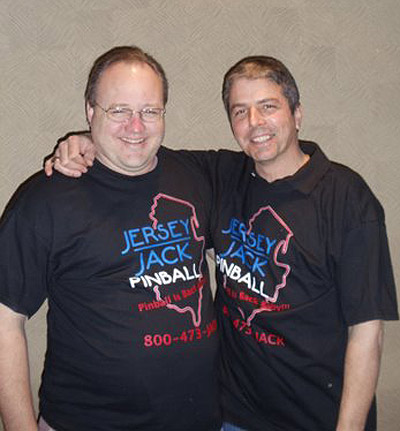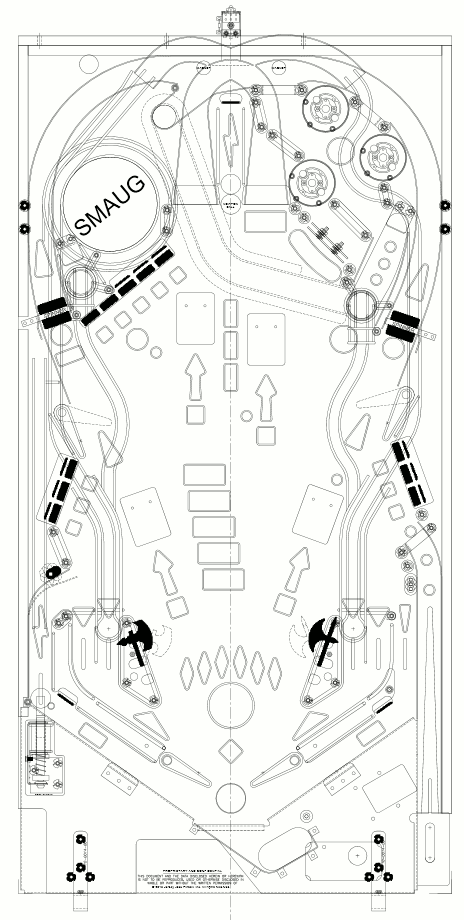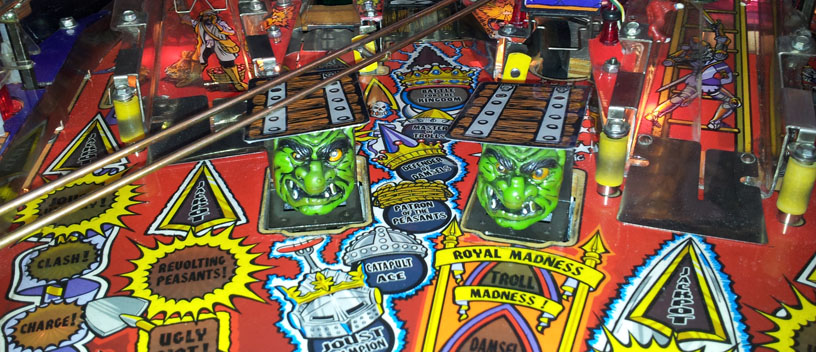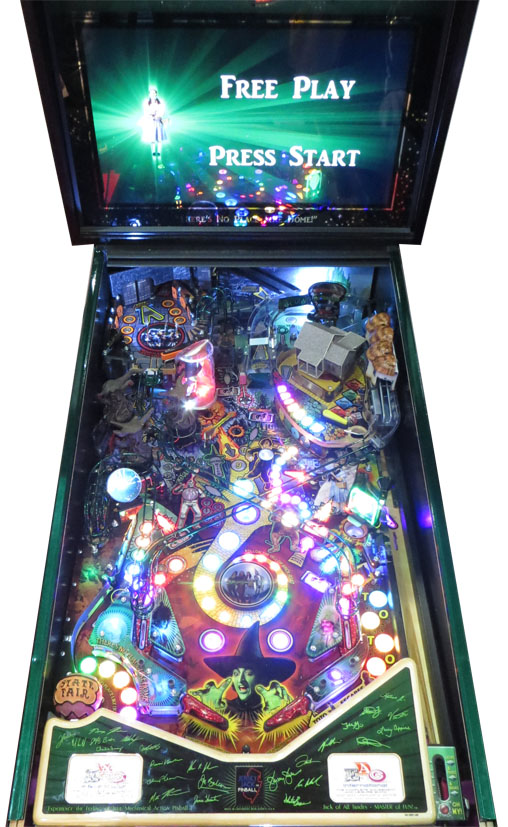To celebrate Pinball Magazine’s first anniversary we’re publishing not one, not two, but three up to the minute interviews with Jersey Jack Pinball crew members. After talking to Jack Guarnieri, Pinball Magazine also spoke with pinball designer Joe Balcer about his latest playfield design for The Hobbit, of which a blueprint was revealed two weeks ago. Joe also talked about Wizard of Oz and how things have changed with The Hobbit.
PM: Joe, two weeks ago the blueprint of the playfield for The Hobbit was released. Have you had any comments about the playfield design?
JB: Yes, we have our WoZ newsgroup and there has been a lot of good feedback on it.
Obviously we’re not going to release it in its entirety, but the basic layout is there. The fun thing about doing that is that people try to figure out “what the heck are they doing here?” It’s interesting to get their feedback and see if that’s in the same direction we plan on going or not. It helps to move the product forward and it gives people an idea of the direction we’re going in.
PM: Is there anything you would like to reveal or clarify about the design?
JB: For Jersey Jack as a company it’s still very early to start revealing how the mechanisms are going to come alive and what the main objectives of the game are.
On this particular layout there’s so much, so many characters, so many locations, so many items that are used throughout the three movies. It’s difficult to put it all in this 23 by 46 inch playfield. If you talk about a widebody: this one could almost be a double wide and we still would probably run out of real estate.
I was looking for a wide-open feel, because of the movie. It’s based on the shire, so I initially wanted to put everything on the perimeter of the game layout and have more of a wide open feel to the shots and the game. Using different mechanisms within that area gives you targets to shoot at that are there one moment and gone the next. It gives it different levels without creating different levels, which I really like about this layout.
PM: One of the first things I asked Jack was whether or not he’s concerned about someone programming a flipping version of The Hobbit layout, now that it’s out there. Is that something you as a designer are concerned about?
JB: I’m not necessarily worried about it.
Personally I don’t like releasing the layout at all, and Jack knows this. I’ve been in pinball for quite a while and I come from an era where we had four, five companies going at the same time. Back then it was Premier, Bally / Williams, Data East / Sega and you had Alvin G that came up and Capcom that came up. To release anything from a game then – that just didn’t happen.
In today’s world it’s different. It’s been Stern for the last twelve years without any competition. They didn’t have to release anything – they just continued to put out pinball machines.
I worked for Gary Stern for more than twelve years and I respect all those guys over there, but I don’t like to give them what I’m doing. Especially in today’s world with the Internet and how fast information moves. We put my layout out there and it was in the competition’s hand in a minute.
Do I worry that someone will turn it into a computer generated layout? No, because it’s not going to be what our final product will be. Maybe it fuels the public to want to be involved or to to purchase the game when it comes out. I don’t really know.
Changes and tweaks
The way it works with Jack is that he likes to release parts of the game, and then give you a taste of what the whole game is. Will that layout be the exact layout when it hits the market? Probably not. There’s going to be changes and tweaks and things that will happen along the way.
So, to give a general idea of what’s going on, I’m OK with that. But to dig in to it and actually put out a lot more details, that’s something that I’m definitely not comfortable with.
PM: Can you reveal anything else about the blueprint?
One thing that comes up in discussions is the four rectangular mechs that are on the playfield. Those are the troll mechs from Medieval Madness.
PM: They look like they could have been trap doors like in Theatre of Magic as well.
JB: It’s funny because the plan was somewhere in between. Are we going to use a trapdoor and three mechs, or do we go two and two? It really still hasn’t been decided, but for all practical purposes they will be the troll mechs.
For this game we have different characters. We have trolls, goblins, orcs – there are so many different characters and what they end up being depends on how the storyline works out as we start to put this thing together with rules. We’ll determine that when we get there, I guess.
PM: How do you feel about The Wizard of Oz now that the game is in production and people are playing it?
JB: Personally I could not be happier that we figured out how to build this game. We started with an empty warehouse and we figured it out. Obviously we all hoped it would have been faster.
We started with the intellectual property from Williams, but a lot of the old stuff out there was never digitized. So we weren’t able to just pick a mechanism and plug it into a layout – we had to go and create libraries to put the game together. Obviously the next one becomes easier and the next one after that becomes easier, because the library grows and you can just pick and choose where you’re going with the game.
To see it running down the assembly line, to hear some of the unbelievable stories that people have of the game… it makes you feel good that people are enjoying what they waited for. I could not be happier that we are delivering now.
PM: How easy was the manufacturing process?
We hit some bumps along the way, but we kept on it and made sure we rectified problems as quickly as we could. And we had to make various tweaks along the way to make our electronics work better, and to make sure our mechanisms were holding up.
But we’re starting to feel a lot more comfortable as a company building a pinball machine for the first time. I have to be honest: one of the worries was that we created a big game. It’s a three-level, wide body pinball machine from a start up company. It’s kind of rolling the dice on that one.
Unbelievable relief
It’s difficult enough to build a simple pinball machine, let alone one that has the bells and whistles we put on this game. To finally be comfortable with that in our production facility is an unbelievable feeling of relief.
We’ve finally crossed that line and I think we can sustain this and just get better at it.
PM: Great! So now that the factory is running and you’ve got more tools to work with, does that make it easier for you designing The Hobbit?
JB: Oh yes, it absolutely does. Another part of it, like on The Hobbit now, is that I know some of the shortcomings that we had on the production line. Some of the issues will work, or do work mechanically, but are a little bit of a problem to get adjusted correctly on the line.
So now that we have learned what our line can do at this point, we keep that in mind while we are laying a game out. Whatever we can do from an engineering standpoint, and make the game easier to build, is definitely the direction we want to go each and every game.
Shortcomings gone
I think we’ve accomplished that, or will accomplish that, when we get The Hobbit to the line, because some of the shortcomings that we had are not going to be there.
Of course there’s probably going to be new difficulties that we encounter, and we will try to work around those ones on the following layout.
PM: The annual Pinball Expo is coming up in October, which is less than two months away. Is there any chance you will present a flipping whitewood of The Hobbit on the Expo floor?
JB: No. Will there be a playable whitewood in two months? I would have to be honest with you and say yes. But to put it out there publicly, with very limited shoot around rules – or even just shoot around – that’s something that I would keep under wraps in our engineering department until we had something of substance to put out there.
We did put some Wizard of Oz games out there that just didn’t have the rule set in. The game got shot, it got played, people liked the game for the shots in it, but there was a lot of negativity and all kinds of suggestions about what we should do here and what we should do there. I don’t think we want to open that door again. I’d rather refine this next one before we have the public shooting at it.
‘No choice’
I’m sure Jack is going to want to release some video of the whitewood shooting, but having it at Expo for everyone to just come up and shoot it, I don’t see that happening. Why take that chance?
With Wizard of Oz we had no choice – at some point you have to come out and show something. But this time, as far as we’re concerned as an engineering group, it’s time to show it when it’s ready to be shown and let people play it when it’s ready to be played, as opposed to rolling the dice and saying “Let’s hope that it’s good enough.”
PM: Did having such a monitor in the backbox of Wizard of Oz affect your deign?
JB: The only thing I can think of is that it enhances the design. My main job is to come up with a good shooting mechanical playfield. How the artist dresses it up on the playfield with the plastics, how the sculptor and the artist come together and decorate the game – obviously I have input on that, but my main objective is to give you a game that is fun to shoot, feels good, you can make all the shots.
When it comes down to the artwork that goes on the playfield and cabinet, the plastics, all the molded parts, and now the monitor: it grows a playfield into a great package.
Pinball changed when it went from the reels to alphanumerics and then it went to dot matrix, and now it has moved again to the LCD. Can we ever go back? No. Do we enhance it more? Do we try to put more content in? Yes, we have to better it, we have to try to go on up on each game. But the enhancement it gives to the game is incredible!
LCD interaction
I don’t think we’ve scratched the surface yet of what we can do with this LCD. On Wizard of Oz I think we tried to put out the ultimate pinball machine with an LCD monitor. We really didn’t interact a lot with the LCD monitor. With games down the road we have another door to open with the interaction between the player and the LCD monitor.
Are we looking to build a video pinball machine? No, we’re looking to build the best mechanical action pinballs, but with the enhancement of the LCD monitor it takes it to a whole different level. Which is, I think, the level that pinball games should be at in 2013.
So that’s the bottom line: we need to get better all the time. That’s what we look at everyday. Each of us comes up with something that you look at and go, “How did I do that? How did that come together?” It all comes with experience and knowing what your company is capable of.
PM: How important is it to design reliable machines?
JB: The reliability part of it is huge.
We don’t just want to make big great awesome pinball machines: we want to make reliable pinball machines. One of the things that has beaten pinball down over the years is reliability. You have to get in there and clean it. The maintenance end of it needs to happen.
What’s important is to stretch out the intervals between which the machine needs to be maintained and mechanisms need to be replaced.
It’s a big deal to us. We did a lot of testing on Wizard of Oz and we’re doing a lot of testing on the new mechanisms that will be on The Hobbit. Games down the road will get huge amounts of testing to make sure that we have something that is reliable.
PM: So the games should hold up at commercial locations.
JB: Yes. The big shift in pinball has been the move to the home. You don’t find locations with pinballs very often, but it’s starting to become more common.
There are pinball rooms opening up again. Earnings are working again, so there’s a comeback. I don’t know how big it’s going to get, how short-lived or long-lived it’s going to be. We have to ride this wave and make good, reliable games and try to keep this wave moving.
Will it ever go back to what it was? Boy, I certainly hope so. That’s why we’re here.
Stay tuned for the third free interview of this week with Wizard of Oz LCD animator Jean-Paul de Win, which will be published later this week.
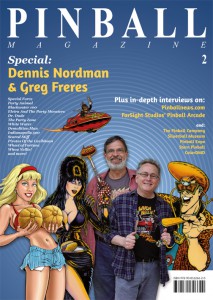
For more Pinball Magazine interviews: check out Pinball Magazine No. 2: 188 pages of in-depth interviews with Bobby King (The Pinball Arcade), Rob Berk and Mike Pacak (Pinball Expo), Randy Perlow and Chris Enright (ColorDMD), Rob Ilvento (Silverball Museum), a career covering cover story on pinball designer Dennis Nordman with lots of input from graphic artist Greg Freres and contributions from pinball industry veterans such as Pat McMahon, John Youssi, Doug Watson, Chris Granner, John Popadiuk, Steve Ritchie, Roger Sharpe, Cassandra Peterson (Elvira) and others.

